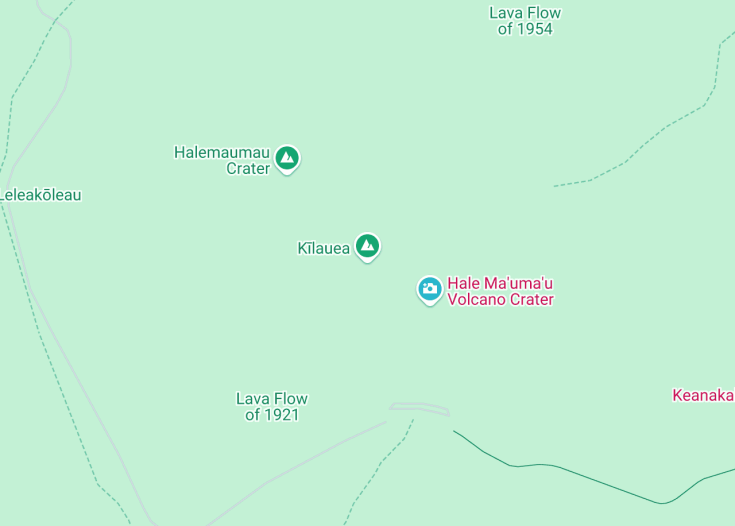Kilauea, located in Hawaii Volcanoes National Park, stands as one of the most active volcanoes on earth. This renowned destination attracts thousands of visitors annually who wish to witness its spectacular natural phenomena. The continuous volcanic activity, dating back to 1983, provides a rare opportunity to observe live lava flows, volcanic ash plumes, and the reshaping of the landscape. Essential to both scientific research and Hawaiian culture, Kilauea offers a profound glimpse into the natural forces that shape our world.
To maximize your experience, visit during the early morning or late evening hours to avoid crowds and to capture the lava’s vibrant glow against a darker sky.
It’s advisable to check the park’s website for current lava viewing conditions and safety guidelines, as volcanic activity can change rapidly.
Kilauea: Nature’s Infernal Wonder
Kilauea, located in Hawaii, USA, stands as one of the most active volcanoes on Earth. This remarkable natural phenomenon attracts countless tourists to Hawaii’s Island of Hawaiʻi each year. Not only is Kilauea significant for its geological activities, but it also holds a profound cultural importance for the native Hawaiian people, embodying the home of Pele, the goddess of fire, lightning, wind, and volcanoes in Hawaiian mythology.
A visit to Kilauea offers a unique insight into the raw and powerful forces of Earth’s interior, displayed through frequent eruptions of lava that create spectacular displays, especially at night. The surrounding Hawai‘i Volcanoes National Park provides visitors with unforgettable experiences, from hiking on volcanic craters to witnessing the growth of new land as lava meets the ocean. The park’s diverse landscapes, rich biodiversity, and educational resources offer an in-depth exploration of volcanic activity and its impacts on the environment. Safety measures and visitor guidelines are strictly enforced to ensure a safe yet thrilling adventure in this extraordinary setting.
Explorations and Activities at Kilauea
Kilauea is not solely a spectacle of volcanic eruptions; it offers a plethora of activities for nature lovers and adventure seekers. Visitors can embark on guided hikes along the park’s scenic trails, such as the popular Kilauea Iki Trail, which takes you through a lush rainforest and into a solidified lava lake. For those interested in a more detailed understanding of the area’s geology, the Thomas A. Jaggar Museum offers exhibits that delve into Kilauea’s volcanic activity and its effects on the island’s ecology.
Overnight Experience
Packing a tent and staying overnight at Namakanipaio Campground provides a unique opportunity to hear the nighttime whispers of the active volcano and witness the stunning starlit skies unobstructed by city lights. Moreover, for a stunning visual display, the Halema‘uma‘u Crater viewing area offers a chance to see glowing lava lakes under the moonlight. Safety is paramount, so staying informed about current volcanic activity and following park guidelines is crucial for all visitors.
The Halema‘uma‘u Crater: Heart of Kilauea
One of Kilauea’s most arresting features is the Halema‘uma‘u Crater. Recently active, this crater has been the site of spectacular lava displays, drawing visitors from around the world to witness the power of Earth’s geological processes firsthand. The crater is deeply rooted in Hawaiian culture as the supposed home of Pele, making this site not only a natural attraction but also a place of spiritual significance. In recent years, significant changes have occurred with parts of the crater floor collapsing and new volcanic vents forming, continually reshaping the landscape. This dynamic environment offers a unique learning experience about the ever-changing nature of volcanic activity. Visitors are encouraged to view the crater from designated overlooks, ensuring both safety and the best vantage points for photography and observation.
Explore the wonders of Kilauea
Kilauea, primarily noted for its volcanic landscapes, is an ideal destination for geology enthusiasts, adventure seekers, and families with older children interested in natural sciences. Visitors to Kilauea can expect a transformative experience, exploring the raw and powerful beauty of one of the most active volcanoes on Earth. The site offers educational tours, guided hikes, and a visitor center packed with informative displays about volcanic activity and its impacts on the local environment.
Best Time to Visit Kilauea
The optimal time to visit Kilauea is during the dry season, from May through October, when the weather conditions are more favorable for hiking and outdoor activities. However, it’s important to check the current volcanic activity and access restrictions that might affect visitation.
Annual Volcano Festival
For those looking for a unique time to visit, the Annual Volcano Festival held in August is a splendid opportunity. The festival includes cultural performances, lectures, and guided walks that illuminate the geological and cultural significance of Kilauea.
Accessibility and Limitations
Kilauea is equipped with facilities to assist visitors with mobility challenges, including accessible trails and viewing areas. However, certain areas might be restricted depending on volcanic activity.
Accessibility
Limitations
- Areas close to the volcanic vents are often off-limits due to safety concerns.
- Drone flying is prohibited without special permission to protect wildlife and the privacy of other visitors.
Notes to visitors
- Wear sturdy footwear suitable for walking on uneven, rocky terrain.
- Be prepared to change your itinerary; volcanic activity may lead to sudden closures.
General Information
Plan your trip to Kilauea with these essential details:
Location
Near the town of Volcano, Kilauea is adjacent to the Hawaii Volcanoes National Park, which provides a more comprehensive exploration of the area’s volcanic heritage.
Address:
123 Kilauea Avenue, Volcano, HI 96785
Opening hours
Daily from 9 AM to 5 PM. Closed on major federal holidays.
Getting to Kilauea
Car
Traveling by car is the most convenient way to reach Kilauea. Ample parking is available on site.
| Route | Distance | Travel time |
|---|---|---|
| From Honolulu | 200 miles (322km) | 5 hours |
| From Hilo | 30 miles (48km) | 45 minutes |
| From Kona | 96 miles (154km) | 2 hours 35 minutes |
Public Transportation
Buses are available from major towns, including Hilo and Kona. Expect longer travel times, particularly from distant locations.
Nearby Attractions
When visiting Kilauea, consider exploring nearby attractions:
- Hawaii Volcanoes National Park – 0.5 miles (0.8 km)
- Volcano Garden Arts – 1.5 miles (2.4 km)
- Akatsuka Orchid Gardens – 3 miles (4.8 km)
- Volcano Winery – 4 miles (6.4 km)
- Hilo Coffee Mill – 22 miles (35 km)
- Punaluu Black Sand Beach – 30 miles (48 km)
- Kapoho Tide Pools – 40 miles (64 km)
- Mauna Kea Observatory – 45 miles (72 km)
- Akaka Falls State Park – 50 miles (80 km)
- Lava Tree State Monument – 54 miles (87 km)
- Hapuna Beach State Park – 75 miles (121 km)
- Kohala Coast – 80 miles (129 km)
Common questions
What is the geological history of Kilauea?
What types of lava formations can be seen at Kilauea?
- Pahoehoe: Smooth and sometimes ropey surfaced lava that is relatively fast-moving in its molten state.
- A’a: A rough, jagged type of lava that moves slowly and hardens into sharp, crumbled rocks.
- Lava Tubes: Hollow tunnels formed by flowing lava that moves beneath the hardened surface of a lava flow. The Thurston Lava Tube is a prominent example that can be explored by visitors.
- Lava Trees: Impressions of tree trunks left in the lava as molten lava flows around them, cooling and hardening.
These varied formations provide a fascinating glimpse into volcanic processes and are accessible through hiking trails and viewpoints around the park.
How has Kilauea impacted the local environment and wildlife?
What are the safety precautions for visiting Kilauea?
- Stay on marked trails and respect all barriers and signs: These are put in place to keep visitors safe from unstable ground and other hazards.
- Check for updates: Always check the park’s website or visitor center for the latest on volcanic activity and trail closures.
- Carry sufficient water and wear appropriate clothing: The area can be deceptively hot and dry, and terrain can be rough.
- Avoid areas with visible steam or gas emissions: These can be hazardous to health due to harmful gases like sulfur dioxide.
Following these precautions will help ensure a safe and enjoyable visit to this dynamic natural wonder.
Are there cultural sites related to Kilauea?
What research and monitoring efforts are in place at Kilauea?
- Seismic Activity Monitoring: Using seismographs to detect and analyze earthquakes which can indicate moving magma.
- Gas Emissions Measurements: Regular sampling of volcanic gases to study changes in composition and volume can give early warning signs of eruptions.
- Ground Deformation Studies: GPS and tiltmeters are used to measure precise changes in the ground surface, which help in understanding the flow of magma beneath the volcano.
- Remote Sensing: Satellites and drones capture high-resolution images to monitor changes in the volcano’s topography and thermal activity.
These efforts allow scientists to study the volcano’s behavior and provide timely warnings for safety measures.
What is the impact of volcanic ash from Kilauea?
- Health risks: Fine ash particles can irritate the respiratory system and exacerbate conditions like asthma.
- Visibility issues: Ash can severely reduce visibility, affecting driving and even grounding flights.
- Damage to machinery: Ash can damage engines and electronic equipment.
- Environmental impact: While ash can enrich soils over time, it can also bury habitats and affect water quality in the short term.
Local authorities provide guidelines on how to handle ash fall during eruptions, emphasizing the importance of staying indoors, using masks, and protecting water sources.
Can you describe the visitor facilities at Kilauea?
What are the typical weather conditions at Kilauea?
Are there guided tours available at Kilauea?
What are the unique flora and fauna found at Kilauea?
What type of volcanic activity is currently observed at Kilauea?

Is Kilauea on the Island of Hawai’i worth visiting?
Kilauea on the Island of Hawai’i is an iconic destination, offering visitors a rare glimpse into an active volcano’s natural beauty and power. However, the experience can be different depending on expectations and timing. While the volcano’s dynamic landscapes and lava flows create a mesmerizing spectacle, these same features can pose safety risks. Hence, it’s essential for tourists to check active conditions and adhere strictly to safety guidelines provided by park authorities.
Additionally, the popularity of Kilauea means it commands large crowds, which can detract from the experience. For the best visit, planning for off-peak times is advised to avoid the busiest periods. If the conditions are right and preparations are made for safety and crowd management, Kilauea is certainly worth a visit for its unique natural phenomena and educational value.










